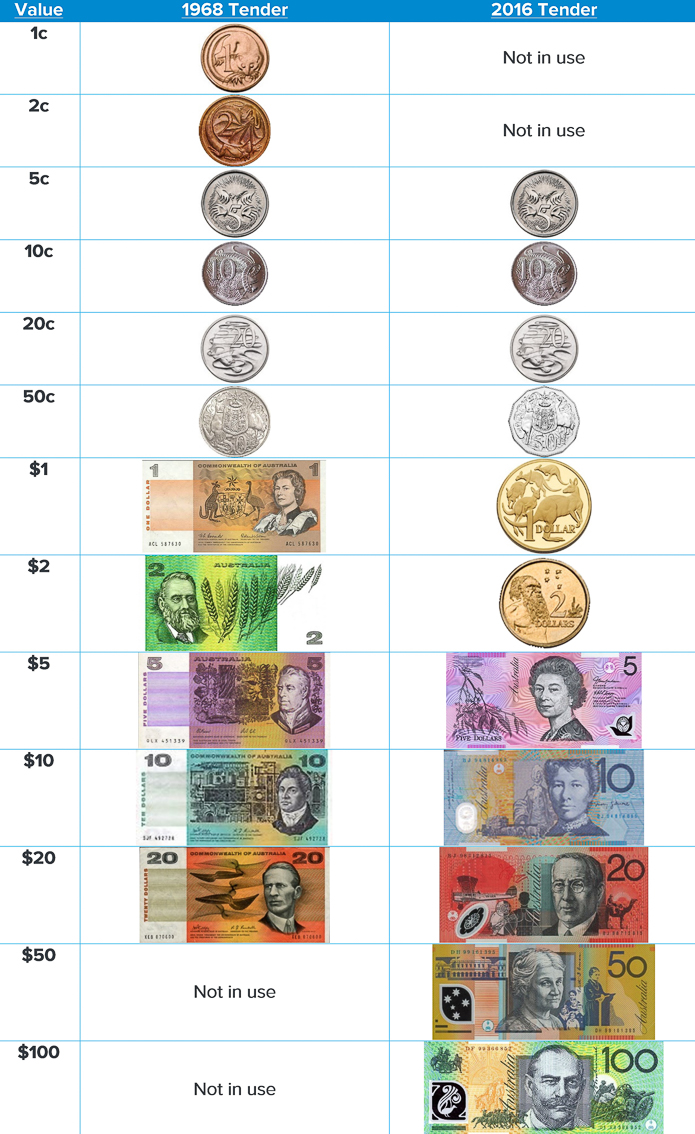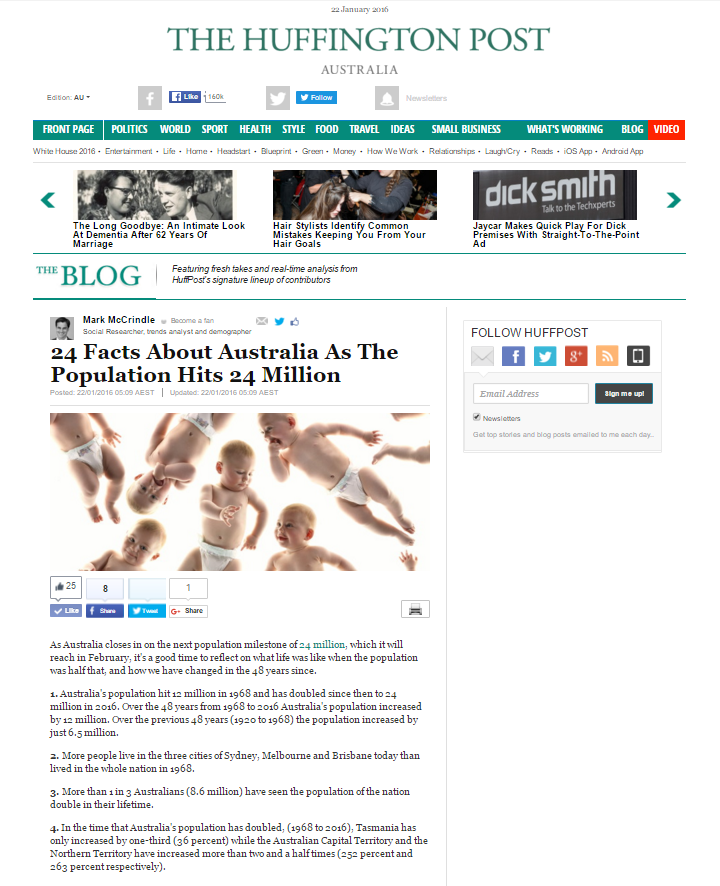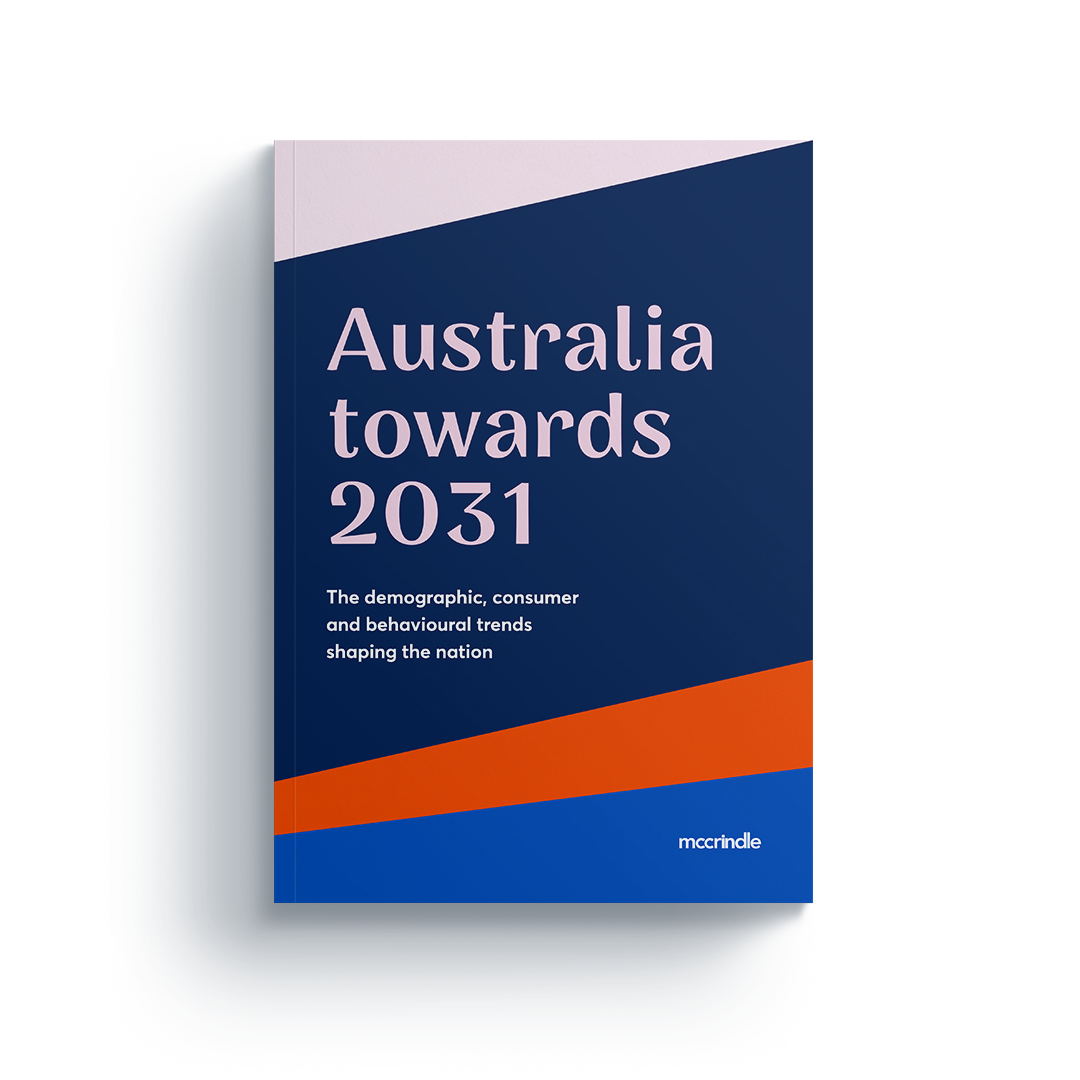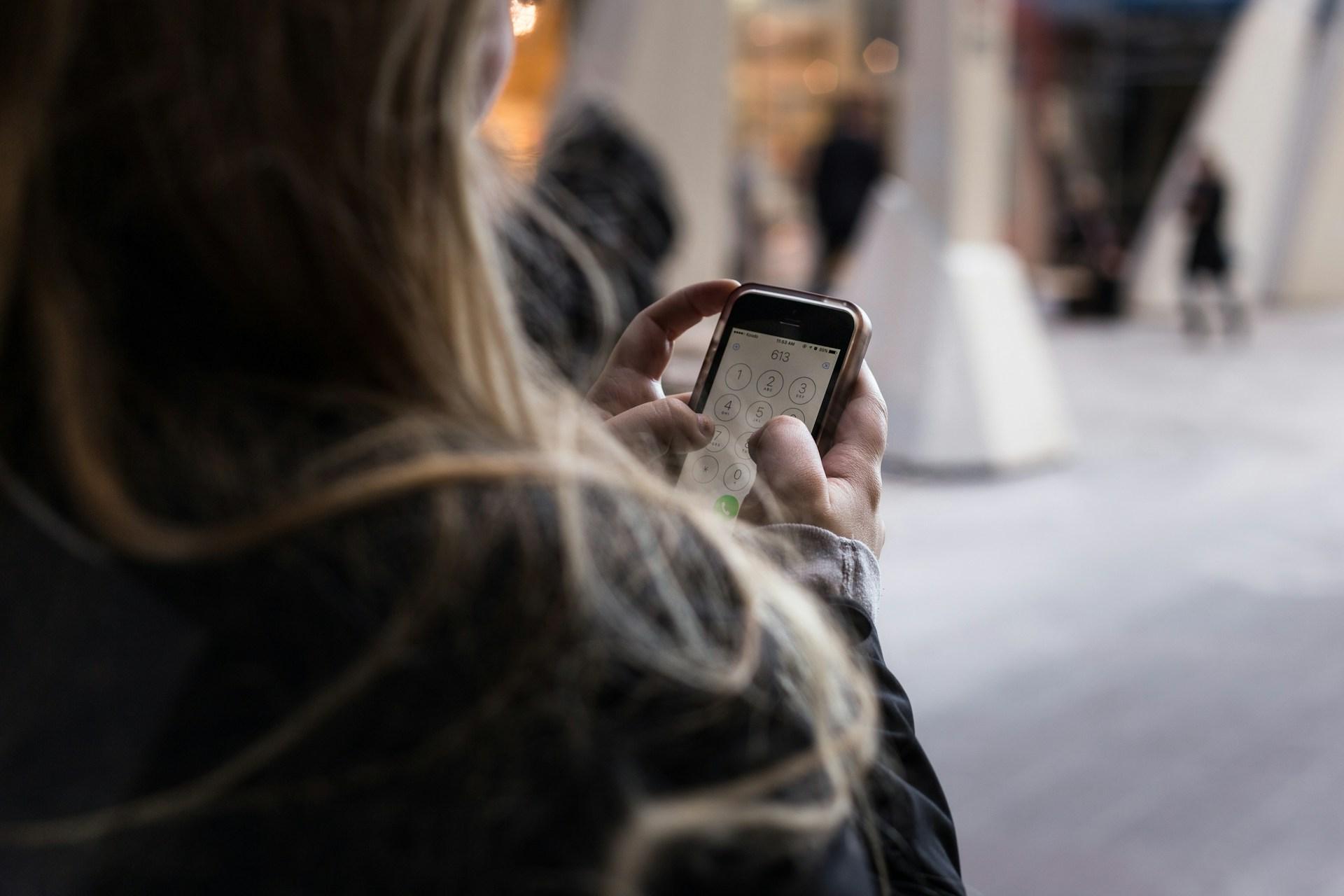24 facts about Australia at 24 million

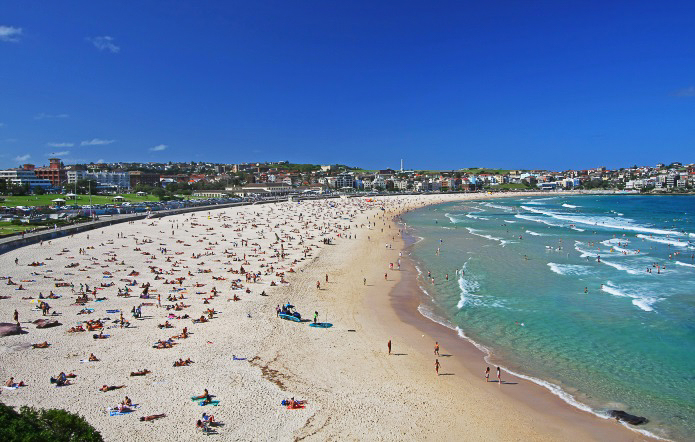 As Australia closes in on the next population milestone of 24 million, which it will reach in February, social researcher Mark McCrindle analyses what life was like when the population was half this- and how we have changed in the 48 years since.
As Australia closes in on the next population milestone of 24 million, which it will reach in February, social researcher Mark McCrindle analyses what life was like when the population was half this- and how we have changed in the 48 years since.
- Australia hit 12 million in 1968 and has doubled since then to hit 24 million in 2016.
Over the 48 years from 1968 to 2016 Australia’s population increased by 12 million. Over the previous 48 years (1920 to 1968) the population increased by just 6.5 million. - More people live in the three cities of Sydney, Melbourne and Brisbane today than lived in the whole nation in 1968.
- More than 1 in 3 Australians (8.6 million) have seen the population of the nation double in their lifetime.
- In the time that Australia’s population has doubled, (1968 to 2016), Tasmania has only increased by one-third (36%) while the Australian Capital Territory and the Northern Territory have increased more than two and a half times (252% and 263% respectively)!

- In 1968, there were 83,807 more males than females while today there are 121,292 more females than males
- 29% of the population in 1968 was aged 0-14 compared to under 19% of the population today, however there are still 1 million more under 15’s today than then.
- In the time that the population has doubled, the number of Australians aged over 65 has more than tripled from 8.4% of the population (1,014,000) to today’s 15% of the population (3,569,556).
- The rate of marriages has dropped by over 40% since 1968 from 8.8 per 1000 population to 5.2 today. However there are around 20,000 more marriages annually than the 106,000 seen in 1968.
- The total birth rate has decreased by a quarter since 1968, from an average of 2.34 births per woman to 1.8 today. However with a population twice as large there are far more births today, exceeding 300,000 annually compared to 240,906 in 1968.
- The death rate has dropped by almost 30% since 1968 and life expectancy has increased by 13.2 years for males and 10.9 years for females to now exceed 80 for males and 85 for females.
- Standard variable interest rates were exactly the same in 1968 as today, at 5.4% while inflation was slightly higher (2.6%) compared to today (1.5%).
- The male average hourly wage was $1.22 and the weekly full time wage was $48.93 which in today’s dollars is $567. The current average weekly full time earnings is almost three times this at $1,484.50.
- Back then 1 Australian dollar bought 1.11 US dollars compared to 0.73 US dollars today.
- The maximum marginal tax rate was much higher at 68.4% on $32,000 and over
while for the 2015-16 financial year it is 45% on $180,000 and over. The tax free threshold has also increased from $416 ($4,800 in today’s dollars) to $18,200 today. - The company tax rate was 40% for private companies and 45% for public companies while for the 2015-16 year it is 30% and 28.5% for small businesses.
- While our population is twice as large, our economy is five times the size it was in 1968. Back then Australia’s GDP was $28,817 million ($334,072m in today’s dollars) while for the 2014-15 financial year was $1,619,195m.
- Men are participating in the workforce much less (male participation rate has dropped from 83.7% to 70.8%) while women are participating much more (up from 37.7% to 59.6%).
- Homes cost 5 times more. The median Sydney house price was around $18,000 (in today’s dollars this equates to $195,300) compared to the current Sydney median house price which exceeds $1 million.
- But milk, butter and potatoes cost less today.
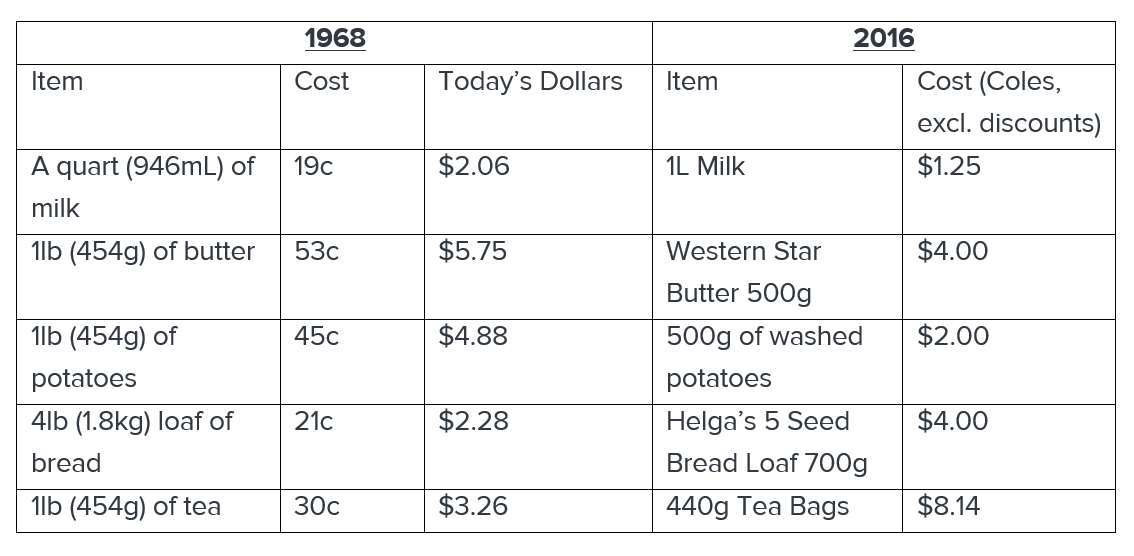
- In 1968 TV was black and white, music was played on record players and the moon had not been reached.
- John Farnham’s Sadie the Cleaning Lady was the top song for five weeks and 1968 was the year that Hugh Jackman and Kylie Minogue were born.
- The postage rate in 1968 was 5 cents for a standard letter compared to $1 today. Most suburbs had twice-daily delivery service compared to the current 3-day delivery times.
- In the 1968 Olympics in Mexico City, Australia bagged 5 gold medals (17 in total) compared to an AOC target of 13 gold medals (and 37 in total) for Rio in 2016.
- Australia was still getting used to the new currency system, moving from the Australian pound to the Australian dollar from 1966 and we’ve gained two new coins and two new notes since then.
1968 = 101.3 males per 100 females
2016 = 99.0 males per 100 females
0-14 years
1968: 29%, 3,486,000
2016: 18.8%, 4, 476,045
The coins in use were the 1, 2, 5, 10, 20 and 50 cent coins. There were also notes with values of $1, $2, $5, $10 and $20.
IN THE MEDIA
About Mark McCrindle
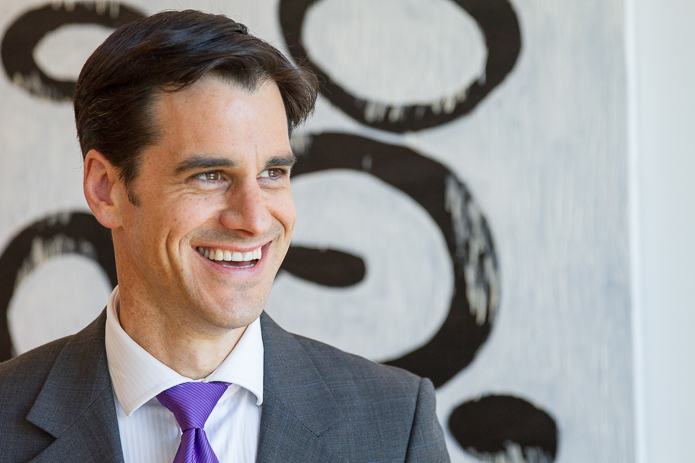 Mark is an award-winning social researcher, best-selling author, TedX speaker and influential thought leader, and is regularly commissioned to deliver strategy and advice to the boards and executive committees of some of Australia’s leading organisations.
Mark is an award-winning social researcher, best-selling author, TedX speaker and influential thought leader, and is regularly commissioned to deliver strategy and advice to the boards and executive committees of some of Australia’s leading organisations.
Mark’s understanding of the key social trends as well as his engaging communication style places him in high demand in the press, on radio and on television shows, such as Sunrise, Today, The Morning Show, ABC News 24 and A Current Affair.
His research firm counts amongst its clients more than 100 of Australia’s largest companies and his highly valued reports and infographics have developed his regard as a data scientist, demographer, futurist and social commentator.
